MiViews Q2 2022: Normalisation Delayed or Derailed?
- Global growth has thus far decelerated in 2022, as lower real incomes and deteriorated savings depress actual spending
- The Ukraine crisis and additional Covid lockdowns in China have further disrupted supply chains and kept inflation high
- Looking ahead, the path of inflation will likely be determined by the reaction of wages to mounting prices in the broader economy
- If the Fed meets current rate hike expectations, the risk of tipping the economy into recession becomes substantial
Overview
Our core scenario for 2022 called for normalisation: economic growth cooling towards potential levels, which combined with easing supply constraints, would allow inflation to cool as well. While the former macro trend has been affirmed, the latter has been, at best, deferred or, at worst, derailed. Figure 1 shows the evolution of our systematic indicators tracking global growth and inflation conditions in real-time, our Nowcasters (which assess traditional macro data) and Newscasters (which assess alternative news data on macro conditions). Growth conditions have normalised significantly, with the faster moving Newscaster suggesting an elevated risk of recession, primarily due to reporting on the economic impact of the Russian invasion of Ukraine and tightening monetary policy. On the other hand, both our Nowcaster and Newscaster point to the stability of a high inflation regime. Importantly, diffusion indices for the Nowcasters have been hovering around 50% or below since the start of the year, which would suggest that these indicators would likely fall in the months ahead. However, the combination of the Russia/Ukraine conflict and additional Covid lockdowns in China have increasingly disrupted supply chains and sent various commodity prices higher, further supporting the level of our inflation indicators.
Figure 1: Growth and Inflation Indicators
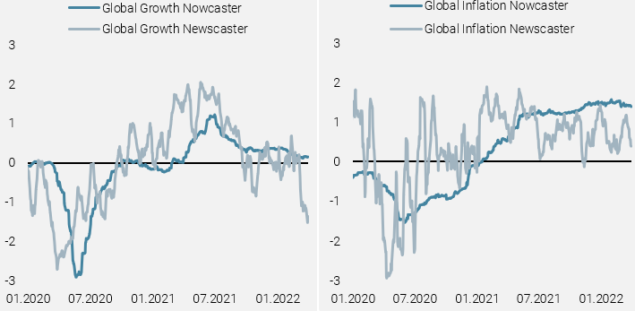
Source: Bloomberg, RavenPack, Unigestion, as of 01 April 2022.
The manner and pace by which these divergent forces reconcile will drive financial markets in the months ahead: will central bankers manage to rein in inflation while avoiding a hard landing? Or are we heading into the late-cycle where the prospect of a recession becomes palpable to investors?
Growth: Lost That Loving Feeling
After an unprecedented fiscal and monetary stimulus in response to the pandemic and ensuing lockdowns, a deceleration in global growth should surprise no one. Importantly, most of the stimulus – direct payments to households and businesses – looks to have passed through to the economy already, with US and European household savings rates back to their pre-pandemic levels. At the same time, real wage growth in the US has been negative for nearly a year (Figure 2), as nominal wage increases have not kept up with inflation.
Figure 2: Real Wage Growth in the US
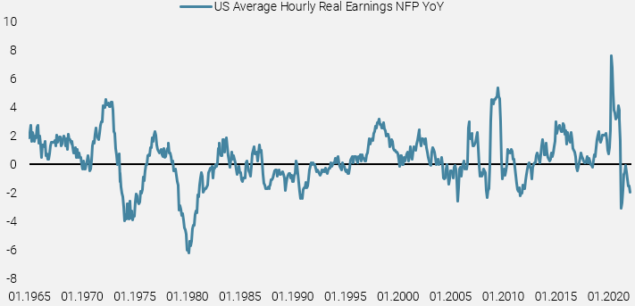
Source: Bloomberg, Unigestion, as of 01 April 2022.
In the context of lower real incomes and deteriorated savings, it is not surprising that actual spending has slowed significantly. Figure 3 charts the month-over-month changes in real retail sales for the US, Germany, and China, demonstrating how significantly the growth in sales volumes has fallen.
Figure 3: Month-over-Month Real Retail Sales (3mma, %)
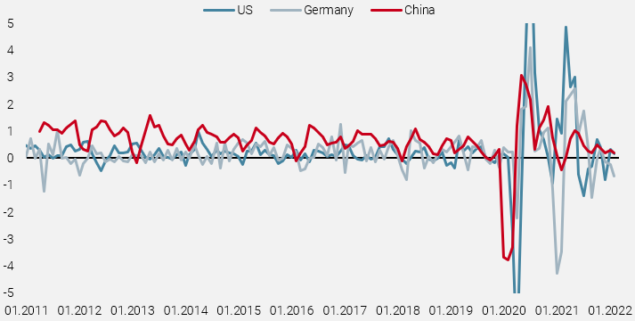
Source: Bloomberg, Unigestion, as of 01 April 2022.
The corporate sector is naturally seeing a marked slowdown in light of the slowing demand. PMIs have been sharply dropping, as shown in Figure 4. The impact of lockdowns in China is especially stark, with sub-50 PMIs indicating economic contraction.
Figure 4: US ISM Surveys (left) and China PMIs (right)
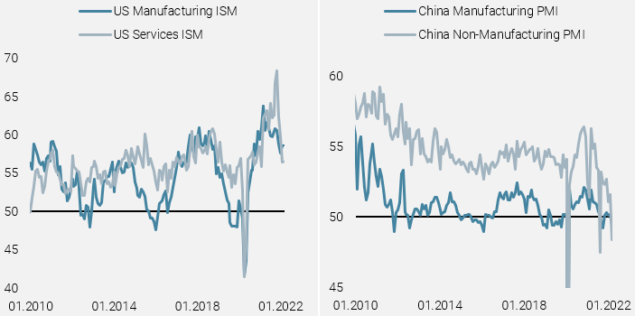
Source: Bloomberg, Unigestion, as of 01 April 2022.
Inflation: Go Big Or Go Home
Slowing demand would typically constrain price pressures, but following further disruptions to supply chains due to the Russian invasion of Ukraine as well as lockdowns in China, commodity prices have continued to surge. Figure 5 charts the price inflation of commodity baskets (left) as well as individual energy commodities (right). While the level of prices makes the headlines (e.g., Brent crude oil hitting over $130/barrel), it is critical to note that the growth in prices has been largely stable, which should stabilise the broader inflation picture.
Figure 5: Year-over-Year Change in Commodity Prices
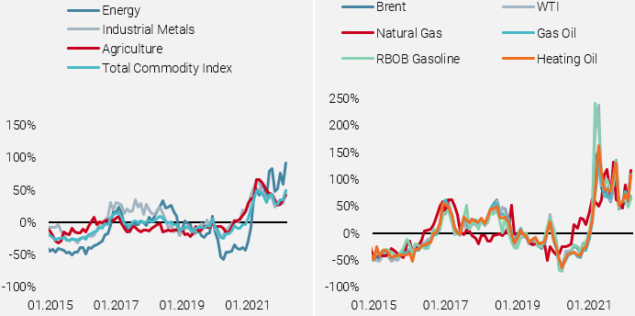
Source: Bloomberg, Unigestion, as of 01 April 2022.
It is also important to understand that inflation is inherently a backward-looking measure, telling you how prices have evolved over the last year. It does not tell you their likely path going forward, which is paramount for investors. Looking ahead, the path of inflation will likely be determined by the reaction of wages to mounting prices in the broader economy. As already mentioned above, real wage growth in the US has been negative for nearly a year, and the same can be said for the Eurozone. Tight labour markets (see Figure 6) have translated into higher nominal wage growth, which have nevertheless been unable to keep apace with inflation.
Figure 6: Unemployment Rates
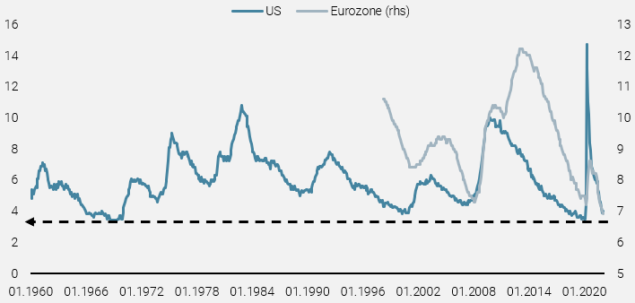
Source: Bloomberg, Unigestion, as of 01 April 2022.
The 1970s are at the fore of many investors’ minds given today’s context, when an inflationary mindset took hold following the 1973 oil shock. Employees asked for increasingly higher nominal wages even as their real wages fell, leading to lower real demand and hence the dreaded stagflation. Inflation expectations have been rising significantly over the last year, but as Figure 7 shows, they are still not at the levels seen during the depths of the 1970s experience. Importantly, longer-term inflation expectations are in line with pre-GFC rates, which suggests that a more lasting inflationary mindset has yet to materialise. The individual decisions among employees and employers over the next few months will ultimately determine whether the current inflationary period abates relatively soon or extends into the years ahead, as part of a vicious price/wage spiral.
Figure 7: University of Michigan Inflation Expectations Survey
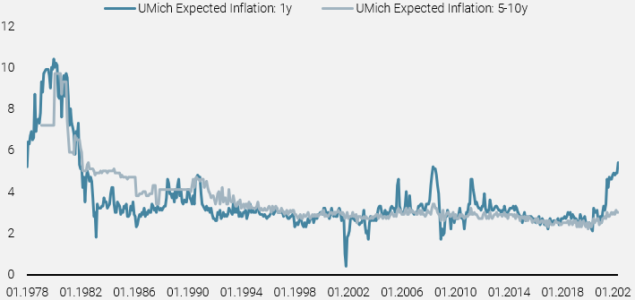
Source: Bloomberg, Unigestion, as of 01 April 2022.
Monetary Policy: Smooth Criminal
One could certainly question mandates about price stability after the repetitive use of the term “transitory” by central bankers last year, but they maintain their critical role in helping to smooth economic cycles, especially during difficult contexts like today. Despite being behind the curve, Fed members now clearly recognise that real rates are too low and need to rise swiftly. In fact, as Figure 8 shows, real rates in the US over two, five, and ten years have been negative and relatively stable for nearly two years. While such an outcome was favourable during the pandemic response, it incentivises economic agents to spend today at the expense of saving for tomorrow.
Figure 8: US Real Rates over Different Horizons
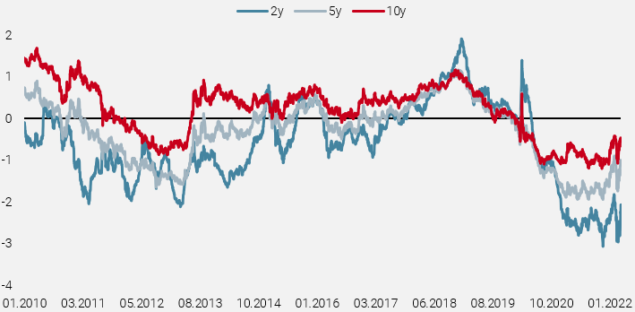
Source: Bloomberg, Unigestion, as of 01 April 2022.
The Fed can achieve a desirable level of neutral real rates by tightening policy (rate hikes for the short-end, QT for the long-end), pushing down market inflation expectations, or some combination of both. Figure 9 shows that markets have priced in over nine hikes in the next twelve months and an additional hike in 2023. If the Fed meets these expectations, and recent statements do point to such an aggressive tightening path, they should be successful in raising real rates and fighting off inflation. However, the risk of tipping the economy into recession is substantial in such a scenario, especially in light of the significant economic slowdown already taking place.
Figure 9: US Monetary Policy Expectations
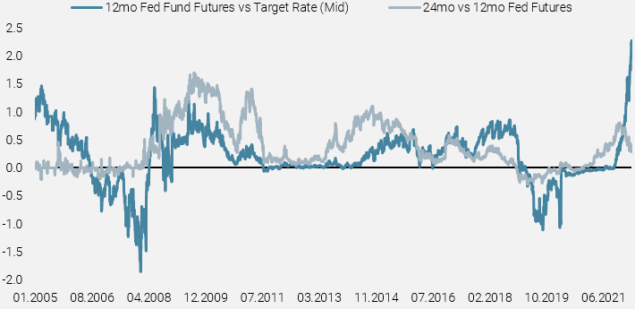
Source: Bloomberg, Unigestion, as of 01 April 2022.
Asset Allocation: I’m So Humble
The current context is challenging for asset allocation: withdrawal of central bank support poses a major headwind for nearly all markets, geopolitics are highly uncertain and with significant outcomes for the global economy, while the prospect of an inflation-driven recession over the next year is making many investors nervous. However, investors look to have adjusted their portfolios significantly to these risks, creating opportunities in some markets. Figure 10 charts the realised beta of different hedge funds to global equities and global bonds, showing how equity allocations among “smart money” managers are neutral to short, while bond allocations are broadly short. Moreover, bond allocations among non-bank investors, including households, corporations, pensions funds, insurance companies, endowments, and sovereign wealth funds, now appear to be back at pre-GFC levels after peaking in 2020, indicating that investors are broadly underweight bonds. While we expect upward pressure on yields to continue while real rates remain negative, attractive entry points should open for long sovereign bonds exposures. Short-term technical factors should also support equity markets, especially those geared to the commodity cycle and buffered from the Russia/Ukraine conflict, leading us to a modest and selective long equity exposure.
Figure 10: Hedge Fund Beta to Global Equities (left) and Bonds (right)
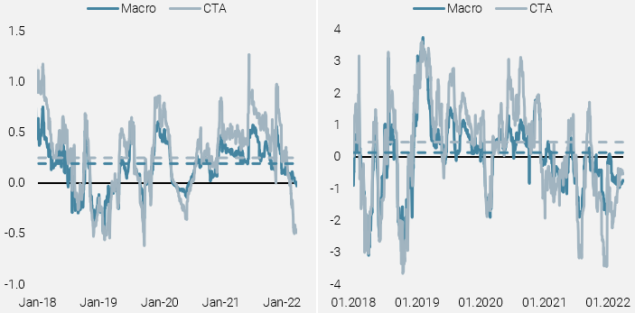
Source: Bloomberg, Unigestion, as of 01 April 2022.
One place where investors do not seem to be under-allocated is commodities. Figure 11 charts the realised beta of hedge funds to the Bloomberg Commodity Index, demonstrating the significant allocation for trend-following strategies, while macro hedge funds are just below their long-term allocation.
Figure 11: Hedge Fund Beta to Bloomberg Commodity Index
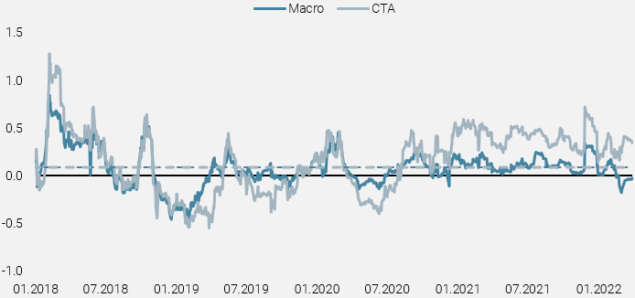
Source: Bloomberg, Unigestion, as of 01 April 2022.
This crowded positioning makes us selective within commodities as well: As Figure 12 shows, oil markets are in strong backwardation, providing significant positive carry as a support, whereas futures curves for base metals (copper shown below) are largely flat, hence our preference for energy commodities over industrial metals. We also remain positive on gold as an inflation and geopolitical hedge.
Figure 12: Futures Curves for Brent Crude (left), and LME Copper (right)
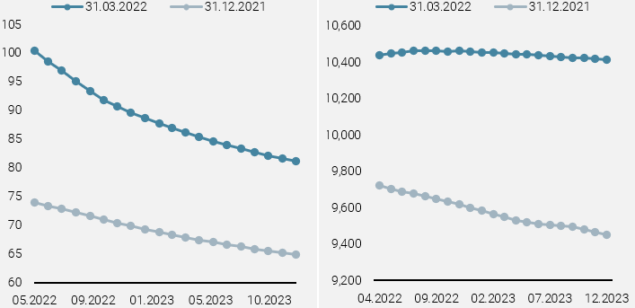
Source: Bloomberg, Unigestion, as of 01 April 2022.
Conclusion
After an eventful start of the year, the second quarter should provide investors with greater insight on the sustainability of the current inflationary environment and the consequent reaction of monetary policy. The key question will be to what extent central bankers can raise real rates to tame inflation without triggering a recession, or whether an inflationary mindset takes hold and drives wages and inflation expectations higher, thereby keeping real yields depressed. Markets are expecting central banks like the Fed to be successful in avoiding a “hard landing”, which is a difficult task at any time, never mind during a major geopolitical conflict. From an asset allocation perspective, with such high levels of uncertainty, we prefer to keep our risk moderate and our exposures selective: underweights in bonds and overweights in equities and real assets are modest and tilted toward markets that we believe will be the most resilient to the risks of monetary policy and geopolitics.
Important information
This document is provided to you on a confidential basis and must not be distributed, published, reproduced or disclosed, in whole or part, to any other person.
The information and data presented in this document may discuss general market activity or industry trends but is not intended to be relied upon as a forecast, research or investment advice. It is not a financial promotion and represents no offer, solicitation or recommendation of any kind, to invest in the strategies or in the investment vehicles it refers to. Some of the investment strategies described or alluded to herein may be construed as high risk and not readily realisable investments, which may experience substantial and sudden losses including total loss of investment.
The investment views, economic and market opinions or analysis expressed in this document present Unigestion’s judgement as at the date of publication without regard to the date on which you may access the information. There is no guarantee that these views and opinions expressed will be correct nor do they purport to be a complete description of the securities, markets and developments referred to in it. All information provided here is subject to change without notice. To the extent that this report contains statements about the future, such statements are forward-looking and subject to a number of risks and uncertainties, including, but not limited to, the impact of competitive products, market acceptance risks and other risks.
Data and graphical information herein are for information only and may have been derived from third party sources. Although we believe that the information obtained from public and third party sources to be reliable, we have not independently verified it and we therefore cannot guarantee its accuracy or completeness. As a result, no representation or warranty, expressed or implied, is or will be made by Unigestion in this respect and no responsibility or liability is or will be accepted. Unless otherwise stated, source is Unigestion. Past performance is not a guide to future performance. All investments contain risks, including total loss for the investor.
Unigestion (UK) Ltd. is authorised and regulated by the UK Financial Conduct Authority (FCA) and is registered with the Securities and Exchange Commission (SEC). Unigestion Asset Management (France) S.A. is authorised and regulated by the French “Autorité des Marchés Financiers” (AMF). Unigestion Asset Management (Canada) Inc., with offices in Toronto and Montreal, is registered as a portfolio manager and/or exempt market dealer in nine provinces across Canada and also as an investment fund manager in Ontario, Quebec and Newfoundland & Labrador. Its principal regulator is the Ontario Securities Commission. Unigestion Asset Management (Düsseldorf) SA is co-regulated by the “Autorité des Marchés Financiers” (AMF) and the “Bundesanstalt für Finanzdienstleistungsaufsicht” (BAFIN). Unigestion SA has an international advisor exemption in Quebec, Saskatchewan and Ontario. Unigestion SA is authorised and regulated by the Swiss Financial Market Supervisory Authority (FINMA). Unigestion SA’s assets are situated outside of Canada and, as such, there may be difficulty enforcing legal rights against Unigestion SA.
Document issued: October 2021.
